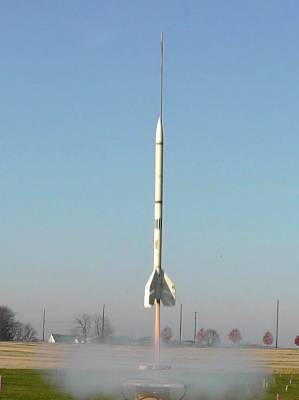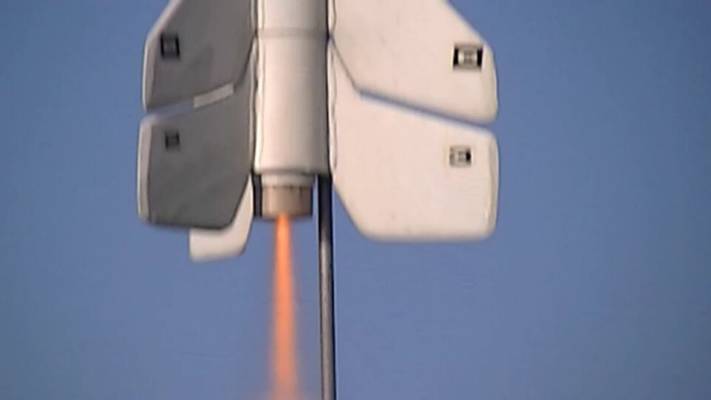The Beta: I love this little gem, but I haven't been able to get T sized booster motors any more.
UPDATE: Estes is now making them again - I have some due to arrive shortly! Yea!!!!!
I think the small size of this rocket combined with its high-altitude capabilities is better off with a bright Mylar streamer instead of the 10" parachute. This makes it easier to spot in the air and on the ground, and reduces drifting in the wind. This rocket was recently given my "Iris" modification, which extends the body tube about 5 inches above the streamer/parachute bay, and allows for a payload with an Altimeter One to measure altitudes. The A-power booster and A-power sustainer really lift this Beta high, over 700 feet on just two A's! I'd say that's pretty good proof that multi-stage rockets are more efficient with propellant, as the same mass of propellant made into a single B-motor would have topped-out at about 500 feet.
After a flight where the second stage did not light for unknown reasons, the Beta was badly damaged. It was repaired with a new and shorter payload section, and the body tube was lengthened to fix the worn-down top of the tube. This rocket is now 19-7/8" long with both stages.
What's great about this kit is you can fly a two stage very economically, since T motors are cheaper than standard sizes. (Iris is named after the Greek god of the rainbow. She is a messenger of the gods, linking the gods with humanity.) This rocket has flown higher than the Revel Casino Towers in Atlantic City, and the Met-Life Tower in NY, and could very easily fly over the St. Louis Gateway Arch.
| Flight Date: | 2012-11-23 |
| Rocket Name: | Beta |
| Kit Name: | Estes - Beta {Kit} (845) [1972-1984] |
| Flyer's Name: | Rich DeAngelis |
| Motors: | A10-0/A3-4 |
| Expected Altitude: | 615 Feet |
| Wind Speed: | 3.00 mph |
| Launch Site: | Penn Manor School Lancaster PA |
| Actual Altitude: | 682 Feet |
I was determined to get two more data points with the A10/A3 motor combo and I finally succeeded after numerous repairs. Spoiler alert: The Beta is in the repair shop again.
It was a beautiful clear morning with very little wind, but quite chilly. This was my chance to try again for 700+ feet, though I knew that was not likely in the colder, denser air.
She lit up and climbed towards the sky with a slight angle, with a peak acceleration of 17.3 Gs. Staging occurred without trouble. With the rocket 13 grams lighter and with less fin area, the second stage brought her to a speed of 132 mph, the fastest speed recorded for this rocket. Average acceleration was 5.6 Gs for the 1.1 second burn, also the highest recorded. I don’t know why the Altimeter 2 always records a 1.1 burn time when the two motors are spec’d at 0.8 and 0.6 seconds for a total of 1.4 seconds. I can only assume it doesn’t detect the fading thrust just before burnout.
The booster landed about 100 feet from the launch pad, while the sustainer coasted for 5.5 seconds to 666 feet where the ejection occurred (1.2 seconds late). Upon ejection the rocket was still coasting up over the curve. In the next 3/10 second the streamer unfurled and the rocket reached an apogee of 682 feet after climbing an additional 16 feet. Not quite the record 700+ but certainly high enough.
The Beta Iris then descended at 13 mph, landing after a 39.7 second flight. This was the longest duration flight ever recorded for this rocket. It landed softly in the tall grass and got a bit wet from the heavy dew. It was a very successful flight.
| Stage | Motor(s) |
|---|---|
| 1 | Estes A10T-0 |
| 2 | Estes A3T-4 |
 |
 |

